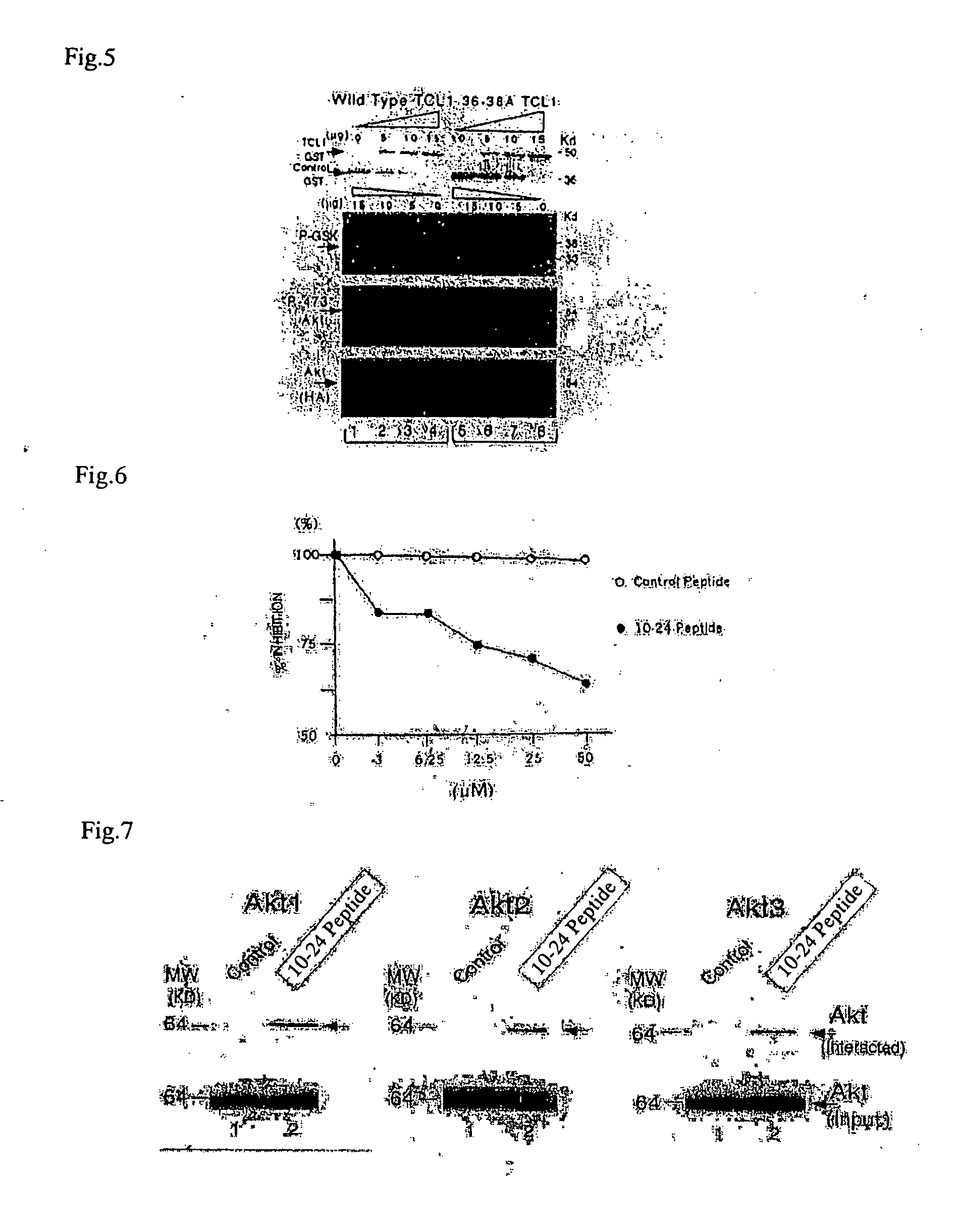Akt activity specifically inhibiting polypeptide
a polypeptide and activity-specific technology, applied in the field of polypeptides, can solve the problems of comparatively limited expression of these molecules, and achieve the effects of inhibiting apoptosis, inhibiting akt activity, and promoting the activation of ak
- Summary
- Abstract
- Description
- Claims
- Application Information
AI Technical Summary
Benefits of technology
Problems solved by technology
Method used
Image
Examples
example 2
Assay for 10 / 24 Peptide of TCL1
[0068]1. Cell Growth Test by using MTT Assay
[0069]Cell growth test was performed by using MTT assay. That is, in experiments of cell growth by using WST-8 reagent [2-(2-methoxy-4-nitrophenyl)-3-(4-nitrophenyl)-5-(2,4-disul fophenyl)-2H-tetrazolium, monosodium salt] (347-07621, Dojin, Kumamoto, Japan) assay, it was identified that amino acid residue sequence 10-24 peptide (NH2—AVTDHPDRLWAWEKF —COOH) of this TLC1 oncogene specifically inhibits cell growth associated with AKT activation (FIG. 6).
[0070]In this method, 10 / 24 peptide was pre-treated at 0-50 μM concentration in cell growth test by using T4 cell lines without stimulation, 48 hours later the growth potency was measured by using WST-8 reagent assay, the absorbance at 450 nm was measured by ELISA using a microplate reader (Model 550; BioRad, Tokyo, Japan).
2. Binding Test by Co-Immunoprecipitation Assay
[0071]To examine the cause of inhibition of the specific cell growth of 10 / 24 peptide, by using...
example 3
Binding Test between 10 / 24 Peptide and Akt Subtype Molecule by using Co-Immunoprecipitation Assay
[0074]Binding test between 10 / 24 peptide and Akt subtype molecule: Akt1, Akt2, or Akt3, was performed by using co-immunoprecipitation assay.
Method:
[0075]The cell lysate overexpressed Akt kinase in 293 cells (ATCC) i.e., Akt1, Akt2 or Akt3 in pCMV6 was expressed in 293 cells (ATCC) by using calcium phosphate method, and the overexpressed cells were harvested, lysed, and pre-treated with Protein G / A agarose mixture (50% v / v, ProG / A, Pharmacia). Akt or a control peptide (βC) was added to the cell lysate at 400 μM, inoculated with ProG / A for 3 hours at 4° C., and was added anti Flag M2 antibody (Sigma). The resultant immune precipitant was washed, and then were identified the binding to Akt kinase by western blotting (anti-HA antibody, 3F10, Boehringer Mannheim). The results are shown in FIG. 7. As shown in the figure, the 10 / 24 peptide bound to any of the three subtypes of molecules, Akt1, ...
example 4
Inhibition Effect Test for Akt Activation by Akt Kinase Assay with the use of GSK (Glycogen Synthesis Kinase 3) as Substrate
[0076]It has been known that Akt promotes phosphorylation of GSK (Glycogen Synthesis Kinase 3).
[0077]With the use of the GSK as substrate Akt kinase assay was performed, and inhibition test for Akt activation with 10 / 24 peptide was performed.
Method:
[0078]In vitro Akt kinase assay was performed by using kit (Cell Signaling, #9840) . Recombinant Akt protein extracted from mammalian cells was mixed with 200 μM concentrations of peptide, and reacted for 2 hours. Phosphorylation was performed for 4 minites at 30° C. After analyzing the reaction mixture on SDS gels, GSK phosphorylation was determined by western blotting. The results are shown in FIG. 8. As shown in the FIG. 8, the 10 / 24 peptide was effectively inhibited the phosphorylation potency for GSK peptide of Akt (three lanes from the left in the figure show the inhibition of GSK phosphorylation diluting the b...
PUM
| Property | Measurement | Unit |
|---|---|---|
| tertiary structure | aaaaa | aaaaa |
| liqid β- | aaaaa | aaaaa |
| structure | aaaaa | aaaaa |
Abstract
Description
Claims
Application Information
 Login to View More
Login to View More - R&D
- Intellectual Property
- Life Sciences
- Materials
- Tech Scout
- Unparalleled Data Quality
- Higher Quality Content
- 60% Fewer Hallucinations
Browse by: Latest US Patents, China's latest patents, Technical Efficacy Thesaurus, Application Domain, Technology Topic, Popular Technical Reports.
© 2025 PatSnap. All rights reserved.Legal|Privacy policy|Modern Slavery Act Transparency Statement|Sitemap|About US| Contact US: help@patsnap.com



